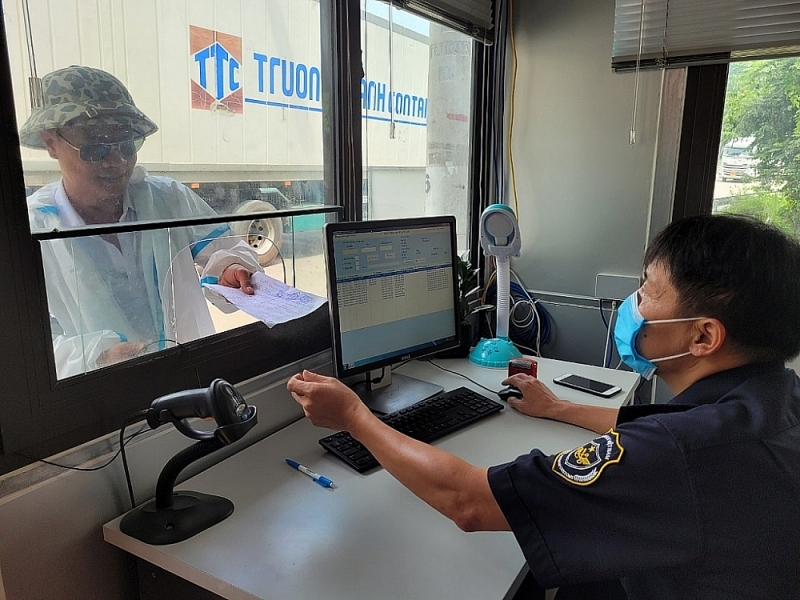 |
| Processing seafood for export at Sao Ta JSC |
Green manufacturing enterprise
According to Ho Quoc Luc, Director of Sao Ta Food JSC, recently, making roof voltage is popular among seafood processing and exporting enterprises. This contributes to the use of renewable electricity. The additional part that needs to be compensated to meet the criteria must be solved in the macro-level preparation. The Ministry of Industry and Trade is interested in this issue when renewable electricity is focused on growth and synchronization.
Improving energy efficiency has been a focus for seafood businesses for nearly 20 years through clean production programs, especially in saving electricity and water. Saving water is also the fourth criterion of efficient and economical use of resources. In the third criterion, which is recycling and circulation, seafood enterprises are performing quite well. Typically, fish and shrimp by-products become raw materials to produce useful products that do not harm the environment but improve operational efficiency. Seafood packaging is also easy to recycle because it is paper and plastic, contributing to reducing waste in the environment.
Guiding green production is not only for businesses but also needs the cooperation of the whole industry. According to Truong Dinh Hoe, General Secretary of Vietnam Association of Seafood Exporters and Producers, for the green transformation of the seafood industry, it is necessary to implement core goals, such as expanding sustainable aquaculture models, effectively managing all fisheries, and upgrading value chains in the aqua-feed system.
Over the next 10 years, the goal of aquaculture should be to expand sustainably to meet the global aqua-feed demand gap, especially in food-deprived areas, while creating income and new jobs. This requires updating aquaculture management by promoting improved planning, legal, institutional frameworks, and policies.
According to Luc, green businesses are not enough, we need the whole green value chain because the links in the value chain are closely related and influence each other significantly. To do so, businesses in the chain must be green and synchronous. Enterprises supplying seed, feed, farming products, and farming establishments must have specific criteria for implementation and consistency throughout the chain. Meeting this requirement, will certainly increase the strong competitiveness of Vietnam’s seafood industry.
Currently, VCCI has a set of sustainable business criteria (CSI) as the foundation for becoming a green business. Seafood enterprises that can meet this set of criteria will soon achieve their expectations instead of waiting for the industry’s own set of criteria.
Sustainable export
Nguyen Thi Hong Minh, Honorary President of the Vietnam Association of Seafood Exporters and Producers, said that climate change posed urgent requirements of environmental protection, towards green production for sustainable export.
Citing examples from EU countries, Minh said that the EU has once again pioneered the issue of standards. In 2019, the EU launched the European Green Deal (EGD) campaign. Among the core regulations, which stand out is the Farm to Fork strategy (F2F – a fair, healthy and environmentally friendly food system). F2F aims to reduce the use of chemical pesticides by 50% by 2030, reduce the sales of antibiotics to animals by 50%, and reduce the use of fertilizers by at least 20%; 25% of agricultural land will be converted to organic production. The EU will ask other countries to do the same or else they will impose tax.
So, what will Vietnamese seafood do to overcome this barrier? Wait for the regulations of importing countries to comply with at a large cost and then passively depend on it; or businesses will take the initiative to take this challenge to build a green brand of Vietnamese seafood on the basis of a set of commercial production standards for green seafood. Simultaneously, set up a seafood business community together to build, protect, and develop a green seafood community on the basis of a common code of conduct, and contribute to the preservation of the common healthy environment.
With regard to the EU’s imminent imposition of F2F on imported food, instead of waiting, Vietnamese businesses actively build a business community on the basis of appropriate standards, which is shown by the common sign of green label, coordinate and share on the basis of code of conduct, and deploy marketing-communication programs to appropriate consumers.
This is an opportunity for seafood to build a real green food production community with internal resources to break through and overcome challenges to reach a new level of development.
According to a representative of VASEP, in fact, implementing a green export strategy not only helps businesses gain a mark of competitive advantage but also enhances financial performance.
Managers of seafood processing enterprises should actively switch to a green export strategy to capture these advantages and enhance competitiveness in export markets.
However, to adopt such a strategy, managers’ “environmental sensitivity” plays a key role. Therefore, managers need to increase sensitivity and commitment to green issues, especially in the export department of enterprises.
